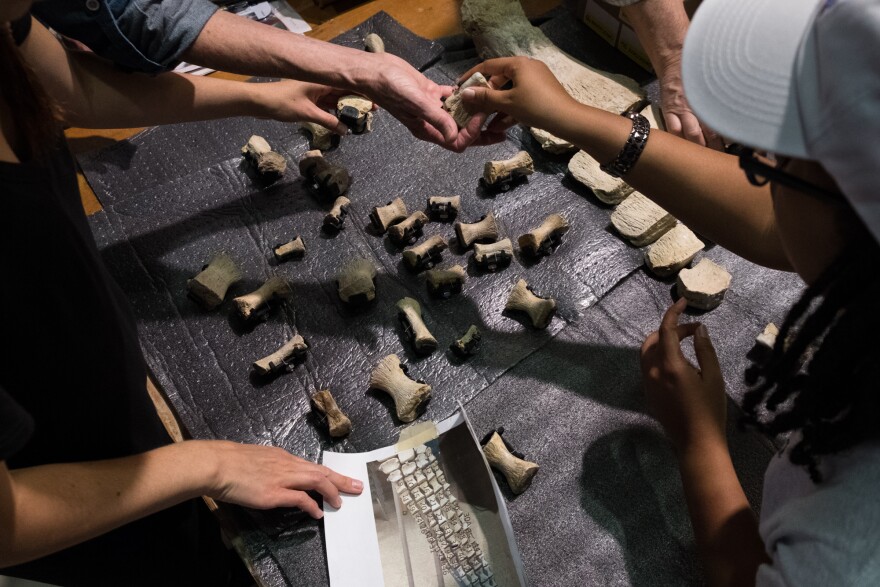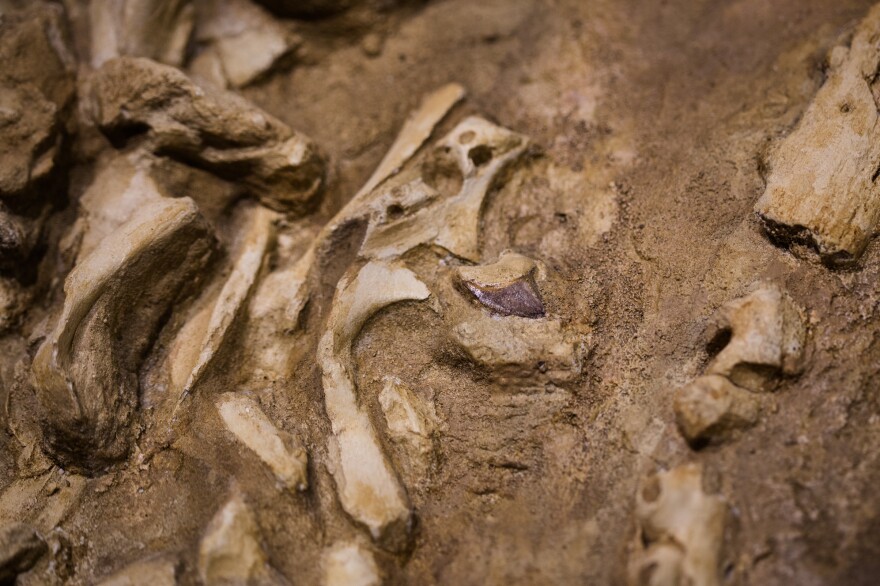When the South Atlantic Ocean was young, sea monsters ruled it.
Some of their bones have turned up along the coast of West Africa and are going on exhibit Friday at the Smithsonian Institution in Washington, D.C. They tell a story of the bloody birth of an ocean.
The fossils of giant swimming reptiles called mosasaurs have been found in the rocky cliffs of Angola, overlooking the Atlantic. It's not a country known for fossils. Few scientists have looked there — half a century of civil war made it too dangerous. But geologically, Angola is special.
About 200 million years ago, Africa was part of the supercontinent Gondwana. Then, about 135 million years ago, that continent started unzipping down the middle. Among the remnants were Africa and South America, which slowly drifted apart. The South Atlantic Ocean filled in the gap between them. It was a time of oceanic turmoil: huge changes in sea level and temperature. It was a brand new habitat, and sea creatures fought to own it.

The mosasaurs won that fight and held on for more than 30 million years.
Paleontologist Louis Jacobs of Southern Methodist University in Dallas has been digging in Angola since 2005. He says fossils from its coastline tell the story of the ocean's earliest days and some of the first creatures that lived there.
"You have an ocean where you didn't have one before," Jacobs says, "and now you have fossils of these marine monsters that are found there. So why did that happen? And why is it them that are there?"
The mother lode of mosasaur bones from Angola are at SMU's paleontology department, where one of Jacobs' colleagues has been reconstructing a mosasaur skeleton for the Smithsonian.

Michael Polcyn started the task in his dining room, but the skeleton got so big that it's now hanging in the department's basement. It's hung up on rods and wires — a sinuous tail and neck, the rib cage and a feeble-looking arm. Mosasaurs looked part lizard and part orca, and they grew up to 50 feet long, about the length of a school bus. They probably had scales and a powerful tail fin similar to a shark's.

During a recent visit, Polcyn was using a pair of pliers to add what look like elongated fingers to one of the arms to make a front limb — a mosasaur paddle. The big tail provided thrust; the animal's four paddles helped it navigate.
"The way mosasaurs move is like lizards," Jacobs says, as if the creatures were still around and not denizens of an ancient past. "Their bodies flex a lot from side to side."
Adds Polcyn: "You can see it was a very optimized swimmer. This was a pursuit predator."
What did it pursue? "Whatever it could get its teeth into," Polcyn says, referring to the rows of 3-inch-long daggers that line the beast's 3-foot-long jaws.
The mosasaurs were not alone; there were turtles and sharks and other large reptiles at the time. But the mosasaurs were the marine equivalent of the tyrannosaurs on land.
The SMU basement has more rooms and lots more bones. Polcyn says Angola was a mosasaur jackpot. "The first time we set foot there, it was incredible," he says. "You couldn't walk one pace without coming across another fossil. The ground was just littered with fossils."
One in particular tells a grisly story. This mosasaur skeleton — Prognathodon kianda, one of six species found in Angola — lies flat on a table in a stone-like matrix, just as it was found in the Angolan rock. The tail is looped, the head twisted back in death. But there are two sets of smaller bones coiled halfway down the beast, as well as some shark's teeth.

It's actually three different mosasaurs — the big one and two smaller ones it ate, Jacobs explains. "They're in the stomach," he says. "And then after the big fella died, you see the shark's teeth from where it was scavenged." No match one-on-one for a living mosasaur, sharks lost their teeth as they ripped the flesh off the dead reptile.
Jacobs says their story is more than just how big and scary ancient reptiles could be. It's about how a new ocean and the conditions for new life were created. How the new Atlantic Ocean rose and warmed. How trade winds stirred up deep water full of nutrients. How those nutrients attracted fish and big turtles. And how they, in turn, attracted big sharks and, ultimately, an explosion of giant reptiles.

"Geology controls destiny," Jacobs says, "in the sense that biology has to adapt to the stage that it's put on."
It was a drama that might have continued if an asteroid hadn't hit the Earth and wiped out the giant reptiles and their dinosaur cousins.
Opening the door to us, the furry little mammals.
Copyright 2025 NPR



